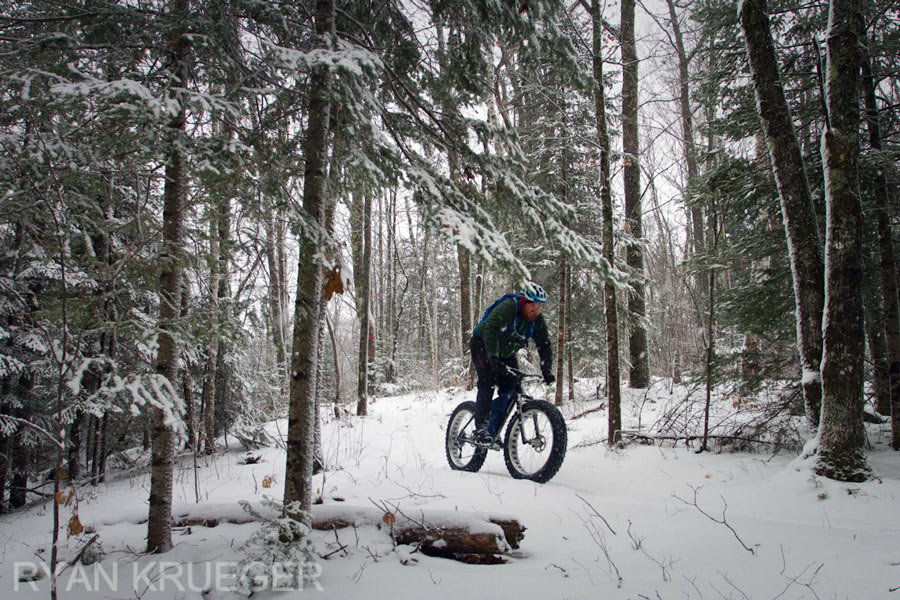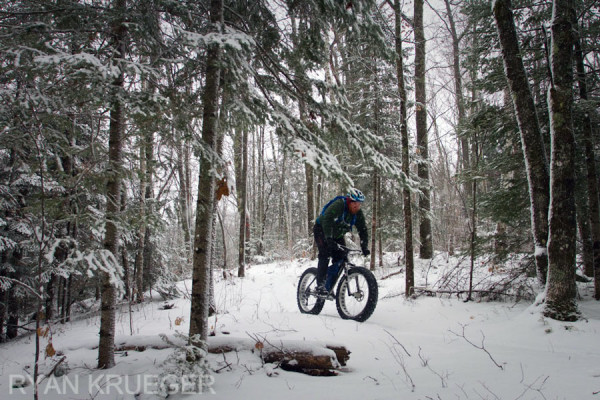
One of the biggest pieces of news from Eurobike this year for fat bikers was that Schwalbe was finally coming to market with a fat bike tire. And not just a single tire, but a 4.0″ and 4.8″ tire in Liteskin (lightweight) and Snakeskin (tubeless easy). The excitement was because of a large player entering the game and bringing tire technology and experience to these large tires, where the weight of a single tire can sometimes be more than the frame they are mounted to.
The actual weights are only a few grams heavier than claimed, which were pretty impressive. We tested the 4.8″ Liteskin version on a Surly Ice Cream Truck, and ripped around the amazing boreal forests of northern Wisconsin on a day with a fresh dusting of 3″ of snow, and more continuously coming down.
Check out our thoughts on this highly anticipated tire after the jump…
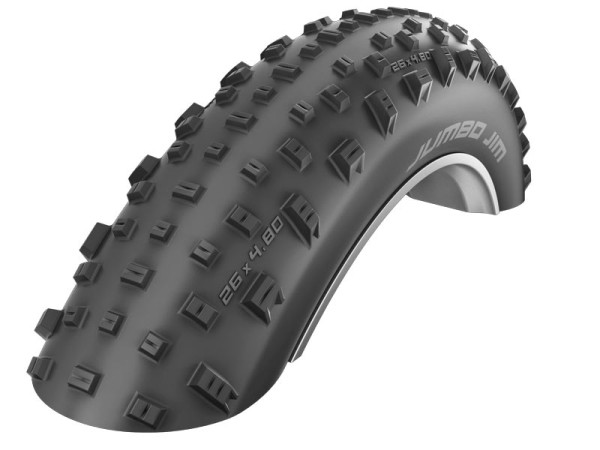
At first glance, the Jumbo Jim looks like a high end tire. Schwalbe does a great job with textures and graphics on their tires, with a matte finish to the tire under the tread, a shinier finish to the sidewalls, attractive logos, and knobs that look high tech with lots of siping. Even for their first entry into the fat bike game, Schwalbe made sure this was a high-end tire, worthy of their name.
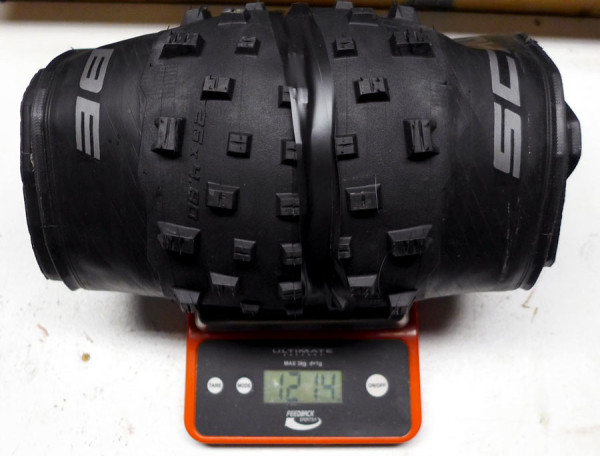
Schwalbe claims the Jumbo Jim 4.8 with Liteskin to be 1,190g, and the actual weight came in at 1,214 grams. Tires of this magnitude have a lot of rubber, and more rubber can lead to a larger variance in manufacturing. A 2% tolerance in the weight is pretty good, considering they are also just getting started up making fat tires. The claimed weights of other similarly sized tires would be the Surly Big Fat Larry 4.7 at 1,400g, Specialized Ground Control Fat 4.6 at 1,450g, and the 45Nrth Dillinger 5 at 1,493g. So when you factor in that Schwalbe can be more than 200g less per tire than competitors, this simple choice can make up to a pound of difference on your ride.
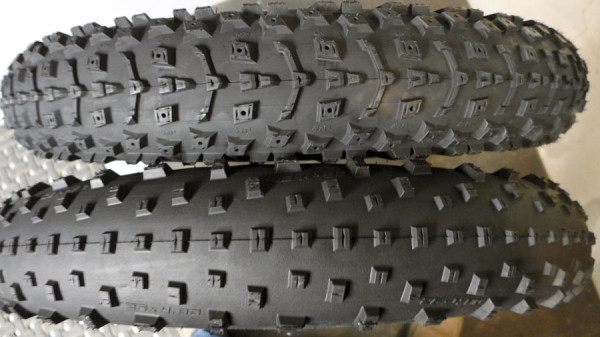
Sitting next to a 45Nrth Dillinger 5 (Dillinger on top, Jumbo Jim on the bottom), you can tell why the Schwalbe tires are so light, as they only have about half of the knobs of the Dillinger. Knobs are usually a pretty solid chunk of rubber, so that can account for a huge amount of the weight savings in the Schwalbe tire. This can definitely be felt on the trail, as the Jumbo Jims feel “slippery”, in that I often could not climb the bike out of the saddle or it would break traction, and the front of the bike felt as if it wanted to wash out from under me if pushed hard into a corner. I can best equate them them to riding a semi-slick cross country tire, if you are normally used to riding a 2.3″ knobby all-mountain tire
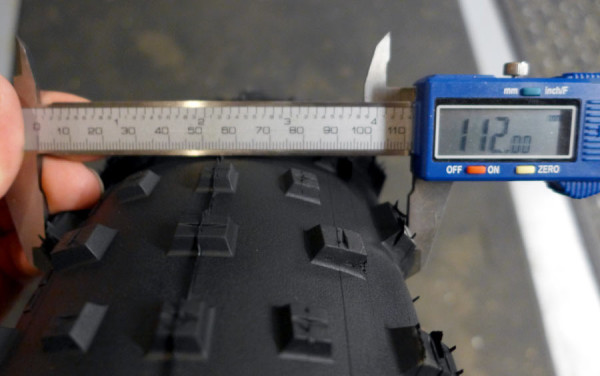
For testing, the tires were mounted to a 100mm wide Surly Clownshoe rim, and inflated to 10psi. On this rim, the casing and the knob both measured the same, at 112mm in width. This is 4.41″, which is a pretty far cry from the 4.8″ claimed. However, we will probably see many tires in the future that actually measure in around 4.5″ or 115mm wide, since the Rockshox Bluto’s tire envelope is 128mm wide, most frame manufacturers are going to design with at least the Bluto in mind and those designers typically try to shoot for 6mm of clearance between a tire and a frame.
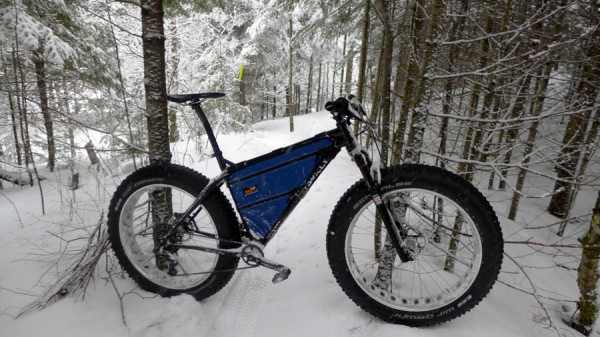
Lighter weight tires are great, unless they start to sacrifice performance. They haven’t been tested in all conditions, but on a snow packed trail where fat bikes get used most of the time, I couldn’t really find a benefit to the Jumbo Jims. Sure they were light, but honestly, I can’t feel the difference on the trail if my 36lb bike is now 35lbs. However, I can feel the lack of traction mentioned above, and it was a relatively negative experience. At $112-$139 depending on model, they are actually pretty affordable when you compare them to the Specialized or 45Nrth at $160. The seem to be aimed at those that will count the grams at all costs, and if that’s your game, then these are the winner.
